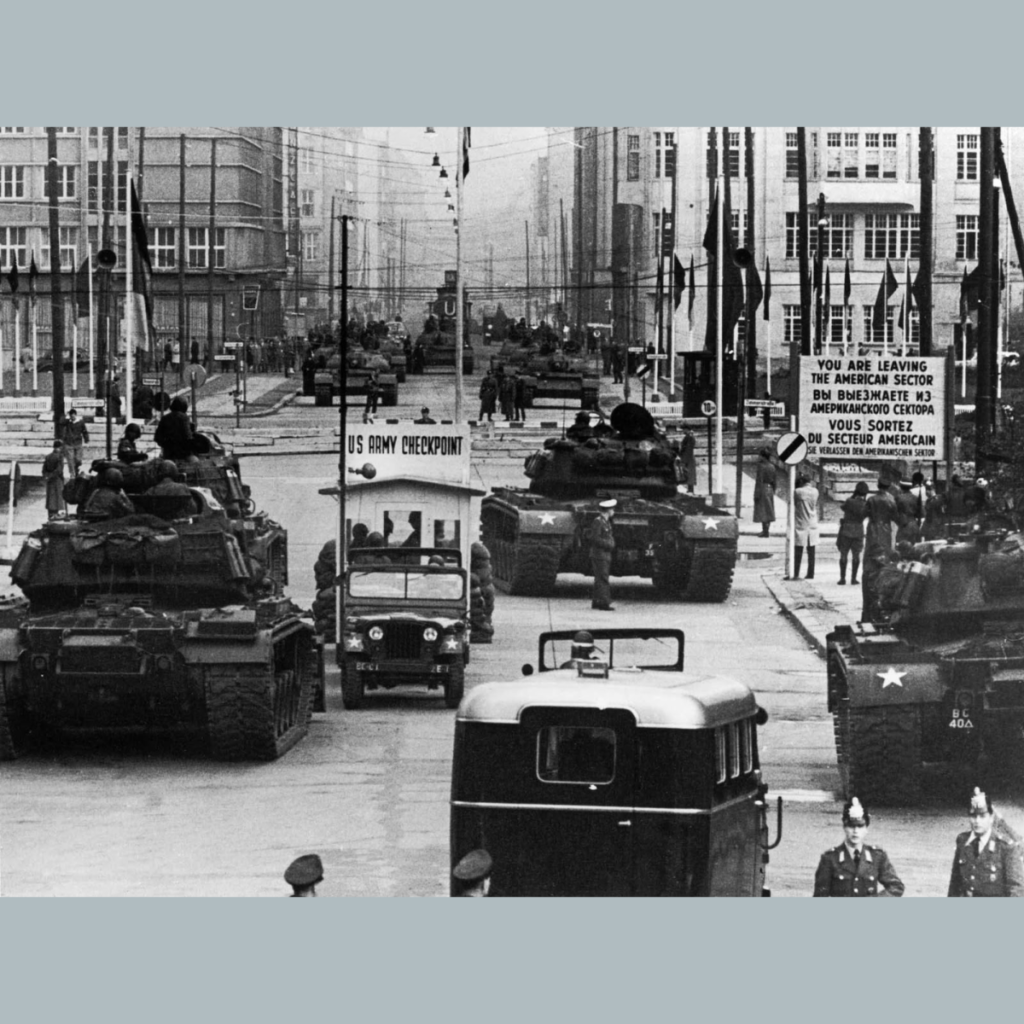
In August 1961 Washington and its British and French allies had failed to prevent the Soviets from building the Berlin Wall.
On October 27, after several days of escalating U.S. rebuffs to East German attempts to get American officials to show identification documents before entering East Berlin (thus indirectly acknowledging East German sovereignty, rather than Soviet occupation authority) ten U.S. M-48 tanks took up position at Checkpoint Charlie.
There they stood, some 50 meters from the border, noisily racing their engines and sending plumes of black smoke into the night air.
Alarmed by the apparent threat, Moscow, with the approval of the Soviet leader, Nikita Khrushchev, sent an equal number of Russian T55 tanks rumbling to face down the Americans.
They too ground to a halt some 50 meters from East/West Berlin. This was the culmination of several days escalation of actions on both sides and the face-off of the Soviet and American tanks, with guns uncovered, the first (and only) such direct confrontation of U.S. and Soviet troops.

Soviet tanks at Checkpoint Charlie October 27, 1961.

East German officials had begun to deny US diplomats the unhindered access to East Berlin that was part of the agreement with Moscow on the postwar occupation of Germany.
By now, American officials were deeply alarmed by the potential consequences. General Clay of the American troops was reminded by Washington that Berlin was not so “vital” interest to be worth risking a conflict with Moscow.
President Kennedy approved the opening of a backchannel with the Kremlin in order to defuse what had blown up.
As a result, the Soviets pulled back one of their T55s from the eastern side of the border at Friedrichstrasse, and minutes later an American M48 also left the scene. Soon the rest of the Soviet tanks withdrew, followed shortly by the reciprocal withdrawal of the U.S. tanks.
Khrushchev had been equally uninterested in risking a battle over Berlin. In return for Kennedy’s assurance that the west had no designs on East Berlin, the Soviet leader tacitly recognized that allied officials and military personnel would have unimpeded access to the East German capital.

American tanks face an East German water cannon at Checkpoint Charlie.

In October 1961, border disputes led to a standoff.
The Berlin crisis arose from what one may term “objective factors” – the fact that West Berlin was an anomalous Western enclave well to the east of the Iron Curtain, precipitating a clash of concrete interests of the Soviet Union and the West.
The confrontations of armed tanks facing off at Checkpoint Charlie is, however, an excellent illustration of how “subjective factors” such as differing perceptions and beliefs of the two sides also contributed to tension – and could even have precipitated war.
What’s interesting is that the sign on the right (first picture) only has German as the fourth language down the list, and in a smaller font than the others.
Until the erection of the Berlin Wall, the differences between the sectors of Berlin didn’t matter much to German citizens. In the early years of the Cold War, they could travel freely throughout the city.
For this reason, the information about the sector borders was printed in the languages of the occupying armies, and not the residents.
The American tanks are M48 Pattons and the Soviet ones are T55s. At this range, they can easily penetrate each other, so the advantage would be with who could reload faster, which would probably be the 90 mm guns on the Pattons rather than the 100 mm guns on the T55s, but the most important factor would be probably who shot first.
